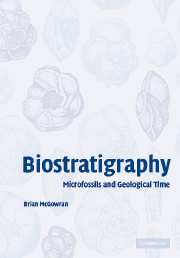Book contents
- Frontmatter
- Contents
- Preface
- Acknowledgments
- 1 Biogeohistory and the development of classical biostratigraphy
- 2 The biostratigraphy of fossil microplankton
- 3 Biostratigraphy: its integration into modern geochronology
- 4 Biostratigraphy and biohistorical theory I: evolution and correlation
- 5 Systemic stratigraphy: beyond classical biostratigraphy
- 6 Biostratigraphy and biohistorical theory II: carving Nature at the joints
- 7 Biostratigraphy and chronostratigraphic classification
- 8 On biostratigraphy and biogeohistory
- References
- Index
3 - Biostratigraphy: its integration into modern geochronology
Published online by Cambridge University Press: 02 December 2009
- Frontmatter
- Contents
- Preface
- Acknowledgments
- 1 Biogeohistory and the development of classical biostratigraphy
- 2 The biostratigraphy of fossil microplankton
- 3 Biostratigraphy: its integration into modern geochronology
- 4 Biostratigraphy and biohistorical theory I: evolution and correlation
- 5 Systemic stratigraphy: beyond classical biostratigraphy
- 6 Biostratigraphy and biohistorical theory II: carving Nature at the joints
- 7 Biostratigraphy and chronostratigraphic classification
- 8 On biostratigraphy and biogeohistory
- References
- Index
Summary
Summary
We come thereby to (bio)chronozones and datums, which contribute an irreversible succession of events (because evolutionary events are unique) to geochronology. This record has been synthesized with magnetochronology (in sediments, volcanoclastics and oceanic crust) and radiochronology to produce the integrated magnetobiostratigraphic scale (IMBS), unique to the Cenozoic Erathem. Homotaxy, the consistent succession of bio-events in space and time, might harbor diachrony, a possibility requiring the disentangling of local or regional biozones from biochronozones. Cyclostratigraphy, explained by Milankovitch astrochronology, contributes not only an independent check on correlation and possible diachrony, but an unprecedented degree of chronological resolution.
Arcane initials aplenty: the CTS, the GPTS and the IMBS
Geological time is extracted from the stratigraphic record comprising the succession of sedimentary strata. Thus we get chronostratigraphy and the construction of the classical timescale (CTS) using radioisotopic dates related opportunistically to the stratal succession. Neither biostratigraphic resolution nor accuracy, although highly desirable outcomes in their own right, bears greatly upon the eternal problems of extending correlations into all environments and situations of interest to Earth history.
Funnell (1964) used biostratigraphically controlled radiometric dates to prepare the first relatively precise Cenozoic timescale. Berggren et al. (1985c) distinguished several approaches to subsequent Cenozoic geochronology. Odin et al. (1982) emphasized radiometric dates to determine the numerical ages of geological boundaries (radiochronology). Berggren (1978) emphasized the role of evolutionary events in organizing the timescale (biochronology).
- Type
- Chapter
- Information
- BiostratigraphyMicrofossils and Geological Time, pp. 47 - 84Publisher: Cambridge University PressPrint publication year: 2005



